On the Link between the Langevin Equation and the Coagulation Kernels of Suspended Nanoparticles
Abstract
:1. Introduction
2. Materials and Methods
2.1. The Population Balance Equation
2.2. The Collision Kernels
2.2.1. Diffusive Regime
2.2.2. Ballistic Regime
2.2.3. Transition Regime
2.3. Langevin Dynamics
2.4. Approximating Langevin Dynamics
3. Results
3.1. Derivation of the Coagulation Kernel
3.2. Proposed Coagulation Kernels
4. Discussion
4.1. Comparison with Experiments
4.2. The Effect on the PSD and the Kinetics of Coagulation
4.3. The Asymptotic Size Distribution and Collision Kinetics
5. Conclusions
- As theoretically shown in this work, the accuracy involved in solving the Langevin equation has a direct impact on modeling the suspended particles’ collision frequency.
- A new and accurate approximation of the mean squared displacement of the Langevin equation in the absence of external forces is proposed. This is an explicit equation that may be used for future theoretical works involving the Langevin equation.
- The new approximation of the Langevin equation allows us to obtain a new equation to predict the collision kernels in the transition regime. This new equation is simple and accurate. For example, it shows less than a 3% error in predicting the coagulation kinetics and less than a 1% error in predicting the particle size distribution along different regimes. It may be used for different applications involving aerosol transport processes such as coagulation and condensation.
- This work brings us additional understanding on the properties of the Langevin equation that have a direct impact on predicting collision kernels. Despite different works in the literature have derived collision frequencies based on Langevin dynamics simulations, discussing the hability of the Langevin equation to predict this phenomena from a theoretical perspective is rarely seen. To the best of the author’s knowledge, there are no previous works deriving the collision kernels theoretically from the Langevin equation, as is the case here.
- The proposed model predicts a likely universal asymptotic kinetics of coagulation in the limit independent of the initial condition (e.g., different particle size or polydispersity). It is suggested that such a limit is due to the self-preserving size distribution as found to be correlated with the asymptotic polydispersity limit. This supports the idea that the physics of coagulation in the diluted regime is well parametrized by the diffusive Knudsen number. It also means that coagulation reaches an asymptotic limit in time with predictable consequences not only for the size distribution but also for the coagulation kinetics.
- The analysis presented in this work may be applied to theoretically study the accuracy of discrete element methods to predict coagulation kernels whether they solve the Langevin equation explicitly [49] or based on Monte Carlo methods [7]. Moreover, this work shows the importance of an accurate solution of the Langevin equation to predict collision kernels successfully. This is significant for choosing a time step in numerical simulations of aerosol dynamics [21].
Supplementary Materials
Funding
Data Availability Statement
Acknowledgments
Conflicts of Interest
Abbreviations
| MSD | Mean squared displacement |
| PBE | Population Blance Equation |
| PSD | Particle Size Distribution |
| NGDE | Nodal General Dynamics Equation solver |
| SM | Supporting Material |
Appendix A. Derivation of Equation (13)
Appendix B. Derivation of the Harmonic Mean Collision Kernel Approximation
Appendix C. Population Balance Code
Appendix D. Volume-Based Geometric Mean and Standard Deviation
References
- Meierhofer, F.; Fritsching, U. Synthesis of Metal Oxide Nanoparticles in Flame Sprays: Review on Process Technology, Modeling, and Diagnostics. Energy Fuels 2021, 35, 5495–5537. [Google Scholar] [CrossRef]
- Muzzio, F.J.; Shinbrot, T.; Glasser, B.J. Powder Technology in the Pharmaceutical Industry: The Need to Catch up Fast. Powder Technol. 2002, 124, 1–7. [Google Scholar] [CrossRef]
- van Ommen, J.R.; Valverde, J.M.; Pfeffer, R. Fluidization of nanopowders: A review. J. Nanopart. Res. 2012, 14, 737. [Google Scholar] [CrossRef] [PubMed]
- Friedlander, S.K. Smoke, Dust, and Haze; Oxford University Press: New York, NY, USA, 2000; Volume 198. [Google Scholar]
- Eggersdorfer, M.L.; Pratsinis, S.E. Agglomerates and aggregates of nanoparticles made in the gas phase. Adv. Powder Technol. 2014, 25, 71–90. [Google Scholar] [CrossRef]
- Jeldres, R.I.; Fawell, P.D.; Florio, B.J. Population balance modelling to describe the particle aggregation process: A review. Powder Technol. 2018, 326, 190–207. [Google Scholar] [CrossRef]
- Morán, J.; Yon, J.; Poux, A.; Corbin, F.; Ouf, F.X.; Siméon, A. Monte Carlo Aggregation Code (MCAC) Part 2: Application to soot agglomeration, highlighting the importance of primary particles. J. Colloid Int. Sci. 2020, 575, 274–285. [Google Scholar] [CrossRef]
- Fuchs, N.A. The Mechanics of Aerosols; Pergamon Press: Oxford, UK, 1964. [Google Scholar]
- Dahneke, B. Simple kinetic theory of Brownian diffusion in vapors and aerosols. In Theory of Dispersed Multiphase Flow; Academic Press: Cambridge, MA, USA, 1983; pp. 97–133. [Google Scholar] [CrossRef]
- Sahni, D. An exact solution of fokker-planck equation and brownian coagulation in the transition regime. J. Colloid Int. Sci. 1983, 91, 418–429. [Google Scholar] [CrossRef]
- Azarov, I.; Veshchunov, M. Development of the new approach to the Brownian coagulation theory: Transition regime. J. Eng. Phys. Thermophys. 2010, 19, 128–137. [Google Scholar] [CrossRef]
- Gopalakrishnan, R.; Hogan, C.J., Jr. Determination of the transition regime collision kernel from mean first passage times. Aerosol Sci. Technol. 2011, 45, 1499–1509. [Google Scholar] [CrossRef]
- Polovnikov, P.; Azarov, I.; Veshchunov, M. Advancement of the kinetic approach to Brownian coagulation on the base of the Langevin theory. J. Aerosol Sci. 2016, 96, 14–23. [Google Scholar] [CrossRef]
- Gmachowski, L. The aerosol particle collision kernel considering the fractal model of particle motion. J. Aerosol Sci. 2013, 59, 47–56. [Google Scholar] [CrossRef]
- Kumar, V.; Menon, S.G. Condensation rate on a black sphere via Fokker-Planck equation. J. Chem. Phys. 1985, 82, 917–920. [Google Scholar] [CrossRef]
- de Monvel-Berthier, A.B.; Dita, P. Brownian motion near an absorbing sphere. J. Stat. Phys. 1991, 62, 729–736. [Google Scholar] [CrossRef]
- Gmachowski, L. Fractal model of the transition from ballistic to diffusive motion of a Brownian particle. J. Aerosol Sci. 2013, 57, 194–198. [Google Scholar] [CrossRef]
- Deng, W.; Barkai, E. Ergodic properties of fractional Brownian-Langevin motion. Phys. Rev. E 2009, 79, 011112. [Google Scholar] [CrossRef]
- Lutz, E. Fractional langevin equation. In Fractional Dynamics: Recent Advances; World Scientific: Singapore, 2012; pp. 285–305. [Google Scholar] [CrossRef]
- Morán, J.; Yon, J.; Poux, A. Monte carlo aggregation code (MCAC) Part 1: Fundamentals. J. Colloid Int. Sci. 2020, 569, 184–194. [Google Scholar] [CrossRef]
- Henry, C.; Minier, J.P.; Mohaupt, M.; Profeta, C.; Pozorski, J.; Tanière, A. A stochastic approach for the simulation of collisions between colloidal particles at large time steps. Int. J. Multiph. Flow 2014, 61, 94–107. [Google Scholar] [CrossRef]
- Langevin, P. Sur la théorie du mouvement brownien. Compt. Rendus 1908, 146, 530–533. [Google Scholar] [CrossRef]
- Berezhkovskii, A.; Makhnovskii, Y.A.; Suris, R. Wiener sausage volume moments. J. Stat. Phys. 1989, 57, 333–346. [Google Scholar] [CrossRef]
- Veshchunov, M. A new approach to the Brownian coagulation theory. J. Aerosol Sci. 2010, 41, 895–910. [Google Scholar] [CrossRef]
- Otto, E.; Fissan, H.; Park, S.; Lee, K. The log-normal size distribution theory of Brownian aerosol coagulation for the entire particle size range: Part II—Analytical solution using Dahneke’s coagulation kernel. J. Aerosol Sci. 1999, 30, 17–34. [Google Scholar] [CrossRef]
- Pomeau, Y.; Piasecki, J. The Langevin equation. C R Phys. 2017, 18, 570–582. [Google Scholar] [CrossRef]
- Zwanzig, R. Nonequilibrium Statistical Mechanics; Oxford University Press: Oxford, UK, 2001. [Google Scholar]
- Uhlenbeck, G.E.; Ornstein, L.S. On the theory of the Brownian motion. Phys. Rev. 1930, 36, 823. [Google Scholar] [CrossRef]
- Hairer, M.; Li, X.M. Averaging dynamics driven by fractional Brownian motion. Ann. Probab. 2020, 48, 1826–1860. [Google Scholar] [CrossRef]
- Hairer, M.; Li, X.M. Generating diffusions with fractional Brownian motion. Commun. Math. Phys. 2022, 1–51. [Google Scholar] [CrossRef]
- Trzeciak, T.M.; Podgórski, A.; Marijnissen, J.C. Brownian coagulation in dense systems: Thermal non-equilibrium effects. J. Aerosol Sci. 2014, 69, 1–12. [Google Scholar] [CrossRef]
- Bec, J.; Ray, S.S.; Saw, E.W.; Homann, H. Abrupt growth of large aggregates by correlated coalescences in turbulent flow. Phys. Rev. E 2016, 93, 031102. [Google Scholar] [CrossRef]
- Trzeciak, T.M. Brownian Coagulation at High Particle Concentrations. Ph.D. Thesis, Delft University of Technology, Delft, The Netherlands, 2012. [Google Scholar]
- Sorensen, C.; Wang, G. Note on the correction for diffusion and drag in the slip regime. Aerosol Sci. Technol. 2000, 33, 353–356. [Google Scholar] [CrossRef]
- Davies, C. Coagulation of aerosols by Brownian motion. J. Aerosol Sci. 1979, 10, 151–161. [Google Scholar] [CrossRef]
- Lee, K.; Chen, H. Coagulation rate of polydisperse particles. Aerosol Sci. Technol. 1984, 3, 327–334. [Google Scholar] [CrossRef]
- Kim, D.; Park, S.; Song, Y.; Kim, D.; Lee, K. Brownian coagulation of polydisperse aerosols in the transition regime. J. Aerosol Sci. 2003, 34, 859–868. [Google Scholar] [CrossRef]
- Kerker, M.; Chatterjee, A.; Cooke, D. Brownian coagulation of aerosols in the transition regime. Pure Appl. Chem. 1976, 48, 457–462. [Google Scholar] [CrossRef]
- Prakash, A.; Bapat, A.; Zachariah, M. A simple numerical algorithm and software for solution of nucleation, surface growth, and coagulation problems. Aerosol Sci. Technol. 2003, 37, 892–898. [Google Scholar] [CrossRef]
- Heine, M.; Pratsinis, S.E. Brownian coagulation at high concentration. Langmuir 2007, 23, 9882–9890. [Google Scholar] [CrossRef] [PubMed]
- Buesser, B.; Heine, M.; Pratsinis, S.E. Coagulation of highly concentrated aerosols. J. Aerosol Sci. 2009, 40, 89–100. [Google Scholar] [CrossRef]
- Veshchunov, M.; Tarasov, V. Extension of the Smoluchowski theory to transitions from dilute to dense regime of Brownian coagulation: Triple collisions. Aerosol Sci. Technol. 2014, 48, 813–821. [Google Scholar] [CrossRef]
- Thajudeen, T.; Deshmukh, S.; Hogan, C.J., Jr. Langevin simulation of aggregate formation in the transition regime. Aerosol Sci. Technol. 2015, 49, 115–125. [Google Scholar] [CrossRef]
- Vemury, S.; Kusters, K.A.; Pratsinis, S.E. Time-lag for attainment of the self-preserving particle size distribution by coagulation. J. Colloid Int. Sci. 1994, 165, 53–59. [Google Scholar] [CrossRef]
- Pierce, F.; Sorensen, C.; Chakrabarti, A. Computer simulation of diffusion-limited cluster-cluster aggregation with an Epstein drag force. Phys. Rev. E 2006, 74, 021411. [Google Scholar] [CrossRef]
- Mountain, R.D.; Mulholland, G.W.; Baum, H. Simulation of aerosol agglomeration in the free molecular and continuum flow regimes. J. Colloid Int. Sci. 1986, 114, 67–81. [Google Scholar] [CrossRef]
- Heinson, W.; Sorensen, C.; Chakrabarti, A. Computer simulation of aggregation with consecutive coalescence and non-Coalescence stages in Aerosols. Aerosol Sci. Technol. 2010, 44, 380–387. [Google Scholar] [CrossRef]
- Goudeli, E.; Eggersdorfer, M.L.; Pratsinis, S.E. Coagulation–Agglomeration of fractal-like particles: Structure and self-preserving size distribution. Langmuir 2015, 31, 1320–1327. [Google Scholar] [CrossRef] [PubMed]
- Isella, L.; Drossinos, Y. Langevin agglomeration of nanoparticles interacting via a central potential. Phys. Rev. E 2010, 82, 011404. [Google Scholar] [CrossRef] [PubMed]

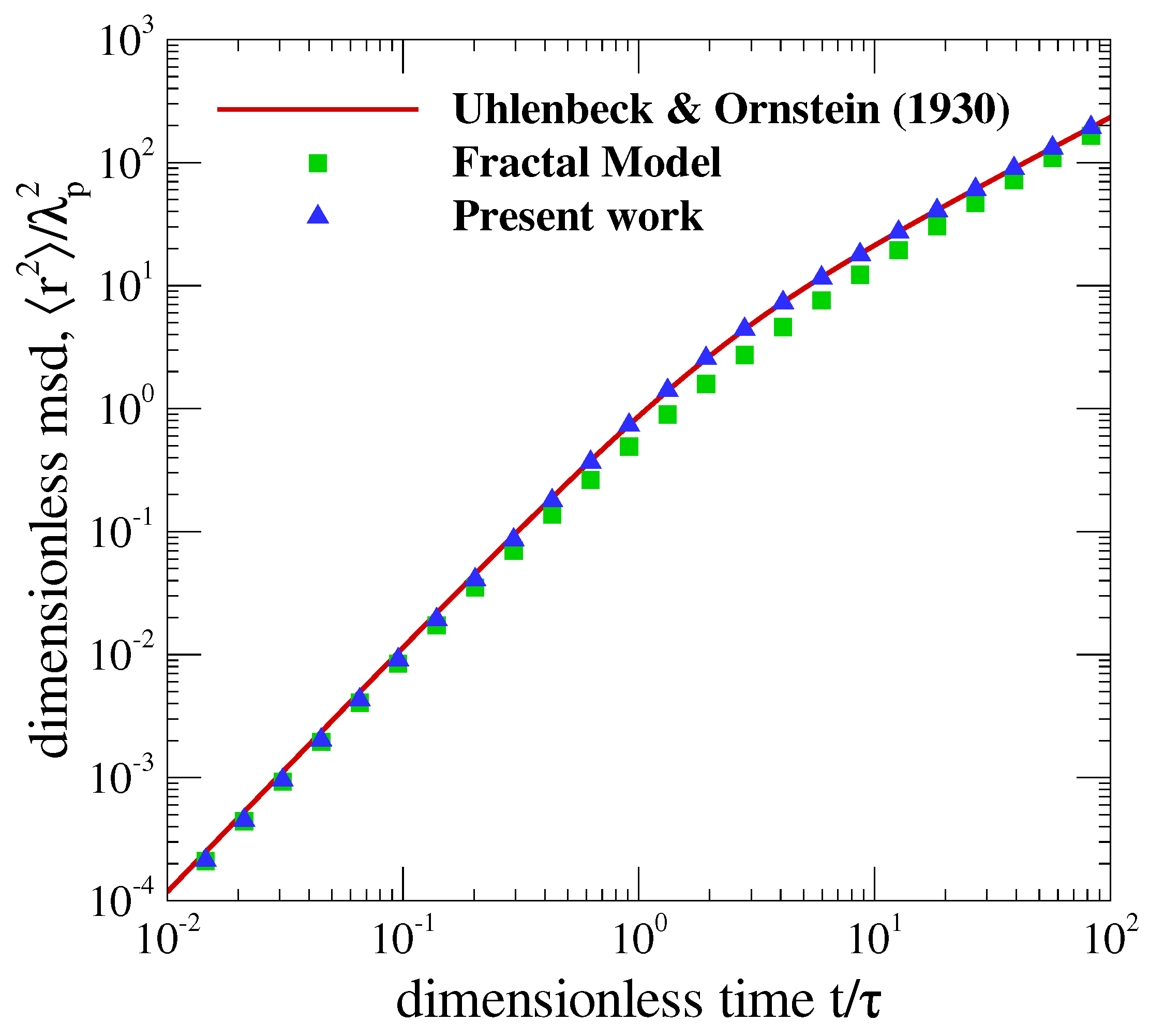
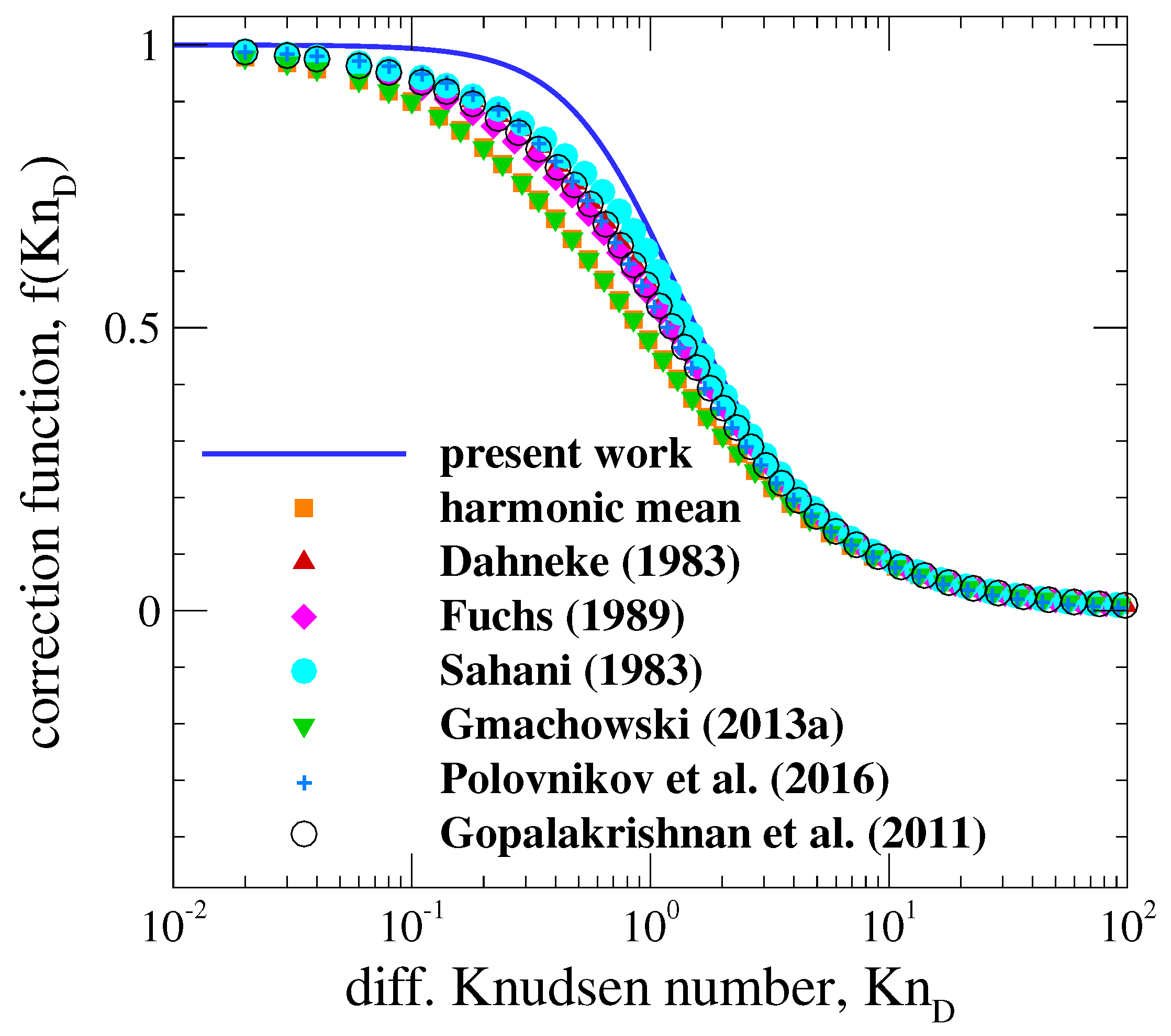
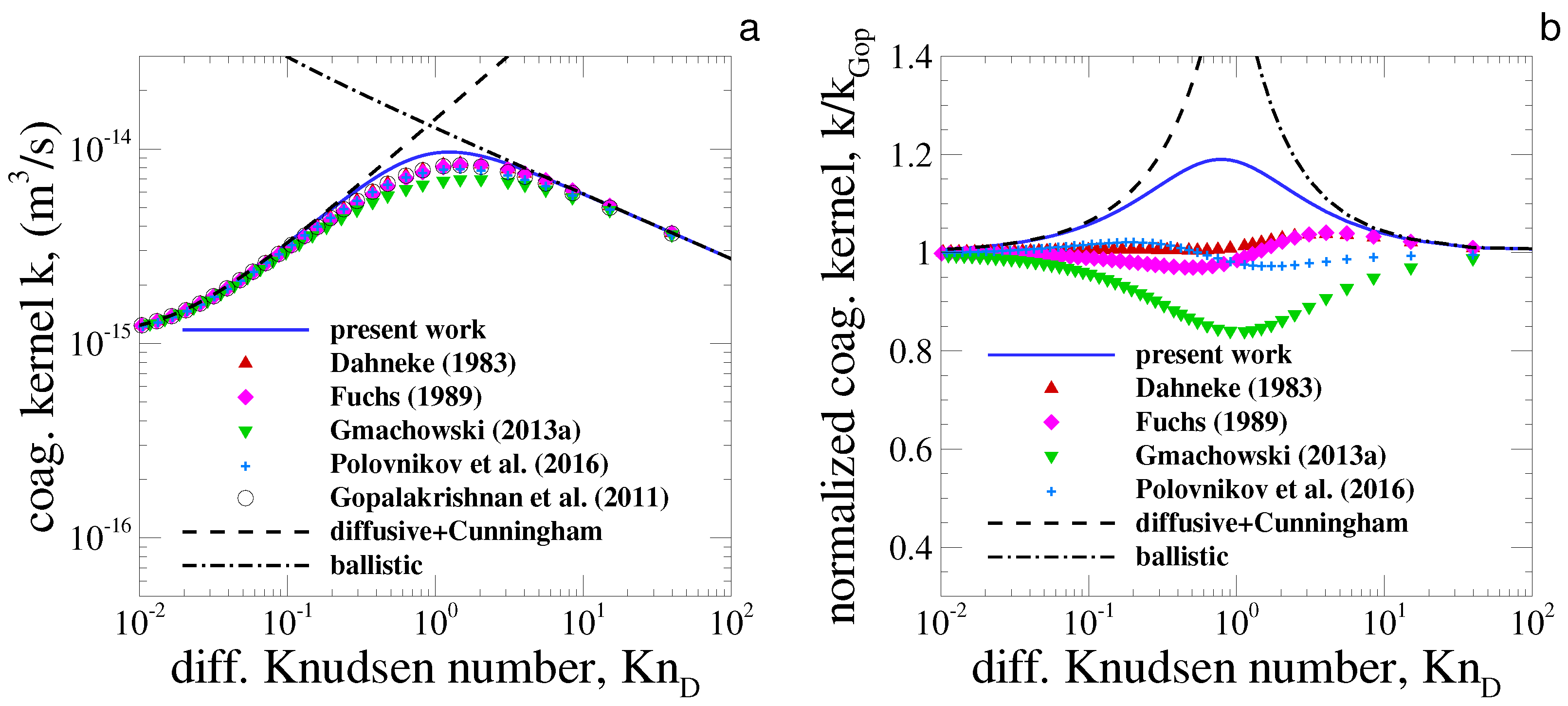
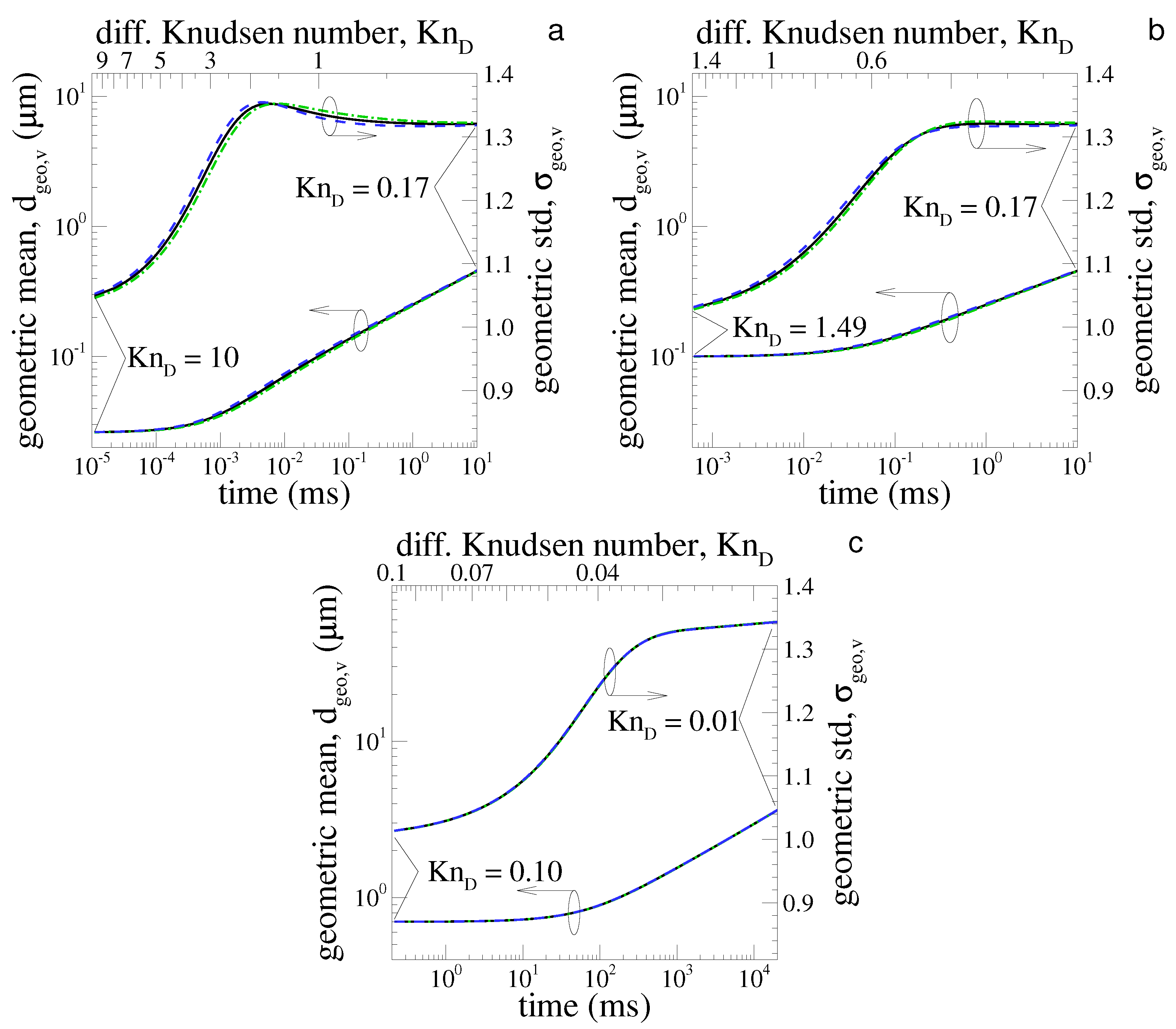

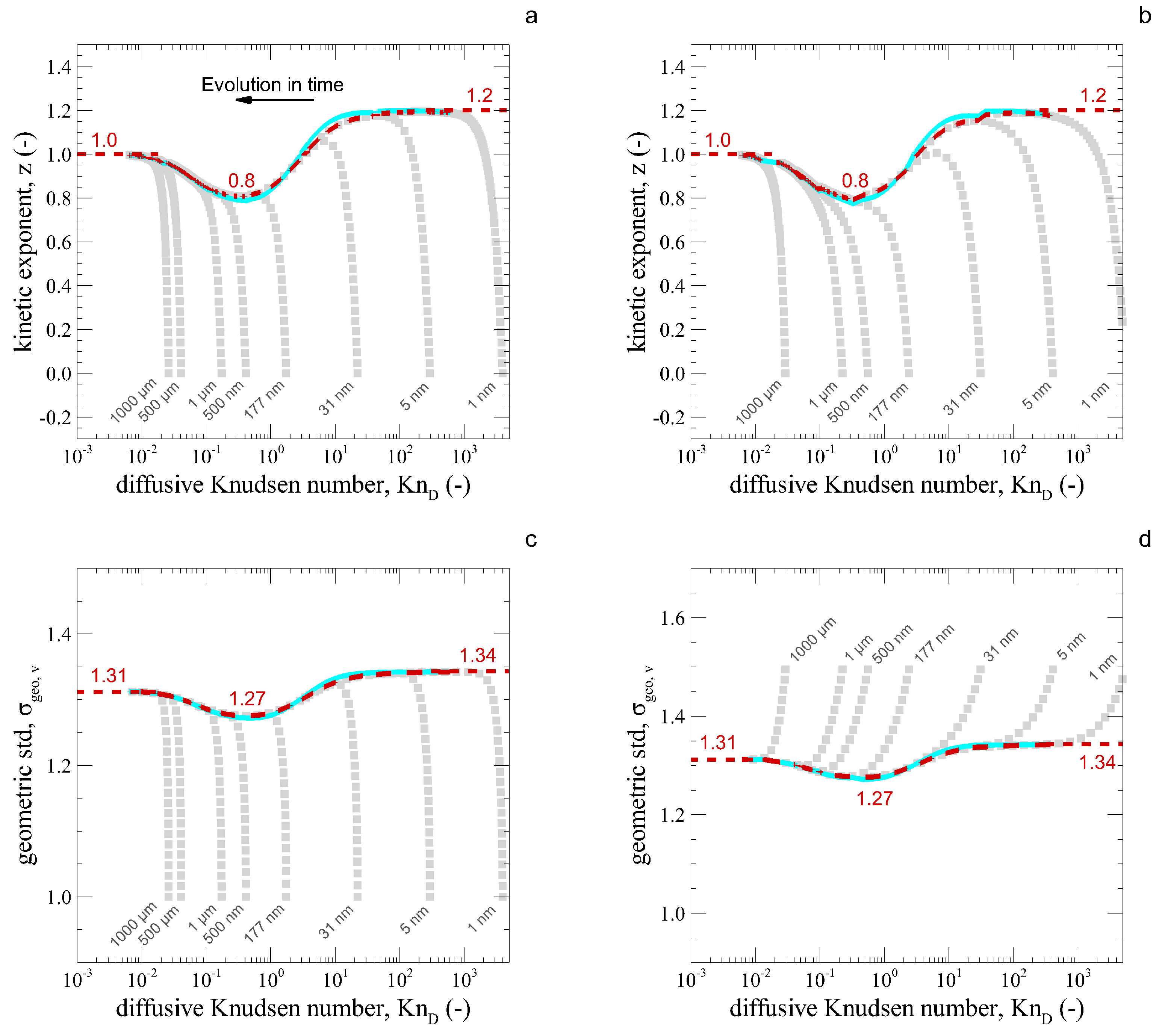
| Reference | Correction Function |
|---|---|
| Dahneke [9] | |
| Sahni [10] | |
| Fuchs [8] | |
| Gopalakrishnan et al., [12] | |
| Polovnikov et al., [13] | |
| Gmachowski [14] | |
| This work |
Publisher’s Note: MDPI stays neutral with regard to jurisdictional claims in published maps and institutional affiliations. |
© 2022 by the author. Licensee MDPI, Basel, Switzerland. This article is an open access article distributed under the terms and conditions of the Creative Commons Attribution (CC BY) license (https://creativecommons.org/licenses/by/4.0/).
Share and Cite
Morán, J. On the Link between the Langevin Equation and the Coagulation Kernels of Suspended Nanoparticles. Fractal Fract. 2022, 6, 529. https://doi.org/10.3390/fractalfract6090529
Morán J. On the Link between the Langevin Equation and the Coagulation Kernels of Suspended Nanoparticles. Fractal and Fractional. 2022; 6(9):529. https://doi.org/10.3390/fractalfract6090529
Chicago/Turabian StyleMorán, José. 2022. "On the Link between the Langevin Equation and the Coagulation Kernels of Suspended Nanoparticles" Fractal and Fractional 6, no. 9: 529. https://doi.org/10.3390/fractalfract6090529






